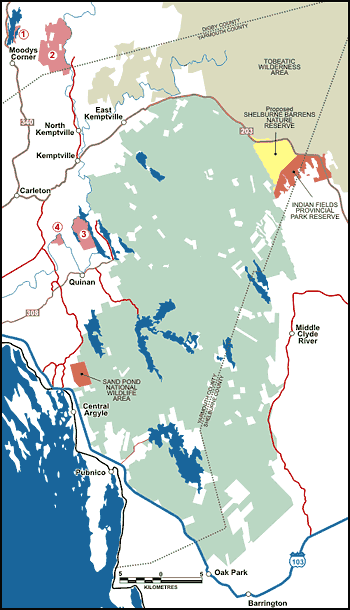| The pollution in the Carlton system represents a significant health risk to the organisms ( plant, animal and human) that inhabit the area and beyond. These polluted waters empty into the Bay of Fundy and threaten the health of one of the richest fishing grounds in the world. Get informed, get active, get involved. Help get the problem fixed. You can make a difference. |
| Bylaw Hearing Monday Sept 28th, 2009
(Extend distance of farms from lakes)
The meeting seams to have been successful. Both sides expressed their concerns. Their were no angry disputes and some of the members from both groups talked and shook hands after the meeting. Both sides agreed that their was a serious problem in the Carleton system with regard to toxic algae. Please send us your views on the meeting.
A WATER QUALITY SURVEY OF NINE LAKES IN THE CARLETON RIVER WATERSHED AREA YARMOUTH COUNTY, NOVA SCOTIA Prepared by Water & Wastewater Branch Nova Scotia Environment Darrell Taylor Project Lead March 18, 2009 (Copy Pdf Format) Source of information and explanation can be found in the letter below; From: trujoben@xplornet.com
Dear Clare Municipal Councillors & Others,
I am very pleased to report that I had a productive phone conversation
last Sunday (Sept. 21) with my Councillor, Dan Hill, about the urgent situation
with the contamination of waterways by waste run-off from SOME mink farms.
After telling him about my meeting with members of a group of concerned
citizens down in Carleton, Dan asked if it would relieve my mind to have
him organize a meeting with them and Clare Council. They have researched
the source and extent of the pollution and assembled a power point presentation
documenting this issue. Of course, I was tremendously relieved--and grateful--to
accept! The Carleton group was too! I am now awaiting word back from them
to set a date for that meeting to happen. THANK YOU, Dan, for your kind
attention and response to my very lengthy phone conversation!
Given the accelerated level of activity on this issue in the Yarmouth/Argyle area at this time, it may be a few weeks before they are free to come up. When they do, I hope that all of you will make a point of being there and treating these incredibly generous neighbours with the respect and consideration they deserve! All they are asking is that Clare put by-laws and associated resources in place to prevent further damage and ensure that appropriate waste management procedures be required and used by all who engage in the industry. I urge those who receive this on time to attend the By-Law Amendment Forum being held in Hebron tonight, Monday, Sept 28th: There will be a By-Law Amendments hearing at the Rotary Centre (Yarmouth
Recreation Complex)
The purpose of the hearing is to discuss increasing the distance between
fur farms and watercourses.
Before closing, I want to add that one of the presenters, geologist
and fieldworker Randy Cleveland, was very interested in learning more about
the use of beneficial probiotic micro-organisms for composting and as a
potential method for cleaning the polluted waters. I was proud to relate
what I knew of the work and research done over the years at Spectacle Lake
and elsewhere in the Municipality of Clare. I also mentioned the Gussing,
Austria adventure. It would be such a wonderful change of outcome
to see a viable fertilizer industry or renewable energy production facility
come from this. Something that generates a positive return on the investment
of energy and resources while leaving our precious waterways intact.
All it takes is a collective vision and lots of hard work to create a scenario
the world would want to come and see! Perhaps the same kind of vision and
hard work that inspired the building of the dykes and aboiteux!
Respectfully,
143 Lower Mill Road, Concession
Attached for your interest:
The Weekender Sunday Sept 27. (http://www.cjls.com/ ) I was not able to find a link to the program. If anyone has that info
please let me know.
Several things I would like to comment on 1. The anonymous letter is that, anonymous and for anyone to say it came from any group or side is only speculation. 2. The statement that
the pollution source cannot be located because it cannot be pin-pointed
is very misleading and is either said in ignorance or as a way to deflect
discussion. Link: ( Locating
the source of pollution.)
Meeting Friday Sept 25. Meeting was well attend hall had standing room only. Brief report on how the groups progress. Entertainment and potluck supper excellent. Concerns were expressed over the state of the river, the seamingly lack of laws to protect this environment. Concerns were also expressed for those mink ranchers who were conscientious farmers. Part of the fear among Yarmouth residents is the lack of transparency in the decision making process and this leads to distrust. The fact that the pollution situation has gotten so far out of hand, ( Nowlans Lake etc.) without any, as of yet, effort by government or farmers to correct a serious situation. The new farm on Sloans Lake has links to the possibly the worst biologically polluted lake in Canada...WELL?. How can "you-all" be trusted? "I look to find reason to believe" We need the jobs, but at what cost?
|
| Q's -
1- Why does Nova Scotia produce more than half of Canada’s mink—and 80 per cent of the province’s mink is raised in this region. Is it because our regulations are stringent, or is it because we apply 3rd world standards? 2- "10 or 11 new licenses issued in the past year." How many more
to come?
Please ask your friends and anyone concerned about the sustainability of our watercourses to attend the Meeting in the Rotary Centre, 105 Cemetery Road in Hebron at 6:30 pm on September 28, 2009. For details on directions to the Rotary Centre please contact the Municipal Office at 742-7159. Any written submission concerning the proposed amendments should be submitted to the Municipal Office at least two days before the Public Hearing. Hopefully someone from each lake/ river in the Municipality will
present.
|
|
Some pictures are very large and may cause older computers to freeze |
| New Tusket: The Birds |

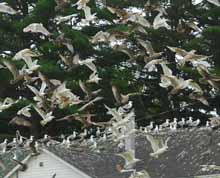
Photos in New Tusket area of mink ranches.. Smell is just the tip of the iceberg with factory farms. The birds are a part that berg I had not even considered. GJL |
| Sloans Lake: Construction Site |
| To: <webmaster@yarmouth.org>
Subject: Sloans Lake Date: Tue, 22 Sep 2009 Aerial photographs taken September 20 showing that the stream running through the property. It appears as though the stream has been compromised. There seems to be a water problem at the wet area just above the logs sitting alongside the road between the two clearings. Also please notice the line running through what appears to be an abandoned road location. Just to the left is a narrowing in the constructed road. I believe this is the equalization culvert referred to by Dept of Natural Resources when they say: "...land was cleared to construct a straight road to the clearing, this path was not used for a roadway, instead they cleared a new path and constructed the road to avoid the brook.... An equalization culvert was installed under the constructed roadway, it was done in a low wet area without a defined channel. This does not require an approval from NSE, as it does not meet the definitions of a watercourse or wetland." The crossing point appears to be the wet area just above the logs sitting
alongside the road between the two clearings. Please zoom in on the wet
spots on both sides of the road.
Rick Murphy
Click on pictures for enlargement |
| Dept of Environ has visited the site and they
say there is no violation
Letter from them to: . Mr. Cleveland, Thank you for your concerns regarding possible watercourse alterations at R & N Farms Limited property, Sloans Lake Yarmouth County. Yes, NSE is responsible for issuing approvals for watercourse alterations. ---Prior to constructing the road the property owners hired a Certified Professional who advised them to construct their road in a manner to avoid the watercourse altogether. As you can see in Photo #1, land was cleared to construct a straight road to the clearing, this path was not used for a roadway, instead they cleared a new path and constructed the road to avoid the brook. The property owners have also implemented erosion sedimentation control methods to ensure an adverse effect does not occur to the brook. An equalization culvert was installed under the constructed roadway, it was done in a low wet area without a defined channel. This does not require an approval from NSE, as it does not meet the definitions of a watercourse or wetland. You pointed out a wet area on the left side of Photo # 2. I was at the site two weeks prior and did not identify a watercourse or wetland in this area, I walked the entire perimeter of the cleared land and did not find any alterations to wetlands or watercourses at the site. NSE staff have been to the site on several occasions. We were also on the site yesterday and no violation was identified. If you require further information you can contact me at 742-8985. Regards, Steve |
| General Information Links |
| From: "Hall" <allendebbie.hall@ns.sympatico.ca>
Date: Wed, 23 Sep 2009 15:25:23 -0300 Hi Here are some web sites related to Blue Green Algae (Cyanobacteria) - the more people know, the better. International
Symposium on Cyanobacterial Harmful Algal Blooms (ISOC-HAB)
Debbie Hall
At 02:53 PM 9/22/2009, you wrote: I just received the attached information from Peter MacDonald on Endangered Species in Yarmouth County. I have also attached an article from Macleans Magazine August 14/09 edition. Thought it would be interesting reading. Related web sites: http://www.speciesatrisk.ca/coastalplainflora/documents/Restrictions_ACPF_Yarmouth_Final.pdf
http://www.gov.ns.ca/natr/wildlife/biodiv/specieslist.htm
http://www.speciesatrisk.ca/municipalities/index.html Debbie Boudreau Mink Industry Pollution By John Horton April 2009 |
| Nowlans Lake: Bacterial Soup |
|
Date: Wed, 9 Sep 2009 21:25:01 -0300
The right bottle contains water from the Sloans Lake in Carleton, where a Mink Farm is intended to be developed. Sloans Lake is one of the very few independent lakes, not linked to the polluted waterways arround. ( Note: It does empty into the Carleton & then the Tusket System and then into the Bay of Fundy food chains. Insert by GJ LeBlanc) NOTHING IS MANIPULATED ON
THIS SAMPLES, THIS IS THE ALARMING THRUTH I SHALL DRIVE YOU UP FOR FURTHER
SAMPLES IF YOU WANT AND I WOULD VERY MUCH WELCOME YOU ON SLOANS LAKE, COME
TO VISIT MY PLACE AND SEE THE TREASURE WE HAVE. Picture to the right (Nowlans Lake)One of he effected lakes at the headwaters of the Carleton system. Sample bottle top left. Microscopic image of -blue_green_algae.gif |
| Italics section, webmaster inserts
Links to other sites may not work as they may be modified by that organization. To: <webmaster@yarmouth.org>,
Good CBC Radio show this morning. For any that did not hear it I will attach a link you will need real player to play it. Don't worry if you don't have it the computer will give you a free download. A interview will be aired on CBC national all over Canada today at 5:00 and 6:00 pm. Dead mink in the Tusket ( Carleton) Water shed area Larger image available a link below as long as they keep link viable. http://www.cbc.ca/information morningns/photo-gallery-archive.html not a good thing to look at. Interview September 4, 2009: Mink Farming Controversy: Reporter Bob Murphy travels to Carleton to investigate the mink farming controversy. Audio available at following link http://www.cbc.ca/informationmorningns/interview-archive/sep.html. or: September 4, 2009: Mink Farming Controversy: Reporter Bob Murphy travels to Carleton to investigate the mink farming controversy. http://cbc.ca/informationmorningns/media/20090904mink.ram Jennifer
|
| Background Information by G.LeBlanc |
| I have noticed in a few emails that their is some
confusion with regard to algae. Algae (seaweed) is not the same as
blue green algae which is a bacteria.
Cyanobacteria, also known as blue-green algae, blue-green bacteria or Cyanophyta, is a phylum of bacteria that obtain their energy through photosynthesis. The name "cyanobacteria" comes from the color of the bacteria (Greek: ?????? (kyanós) = blue) (source) Algae (pronounced /?æld?i?/; singular alga /?æl??/,
Latin for "seaweed") are a large and diverse group of simple, typically
autotrophic organisms, ranging from unicellular to multicellular forms.
The largest and most complex marine forms are called seaweeds.
|
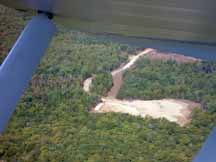
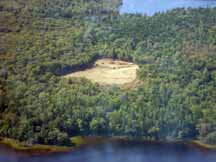
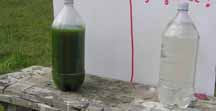
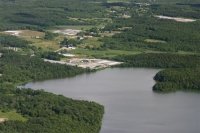
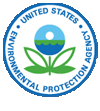 Nutrient
pollution, especially from nitrogen and phosphorus, has consistently
ranked as one of the top causes of degradation in some U.S. waters for
more than a decade. Excess nitrogen and phosphorus lead to significant
water quality problems including harmful algal blooms, hypoxia and declines
in wildlife and wildlife habitat. Excesses have also been linked to higher
amounts of chemicals that make people sick.{ (
Nutrient
pollution, especially from nitrogen and phosphorus, has consistently
ranked as one of the top causes of degradation in some U.S. waters for
more than a decade. Excess nitrogen and phosphorus lead to significant
water quality problems including harmful algal blooms, hypoxia and declines
in wildlife and wildlife habitat. Excesses have also been linked to higher
amounts of chemicals that make people sick.{ (
